
Hoa Binh
How to travel to Hoa Binh for your best experience
Hoa Binh Travel Guide – What to do, when to visit, and more…
The lush, mountainous Hoa Binh is a province in Vietnam’s north-western region, just 70km from Hanoi. Home to five different ethnic groups who live in picturesque villages surrounded by verdant rice paddies and green hills, Hoa Binh is one of the most peaceful and pleasant areas you may find in Vietnam. Hesitate no more, let’s find out how to travel to Hoa Binh for your best experience before packing up and booking a trip to visit the land.
Frequently asked questions
1. Trekking the wonderful Mai Chau Valley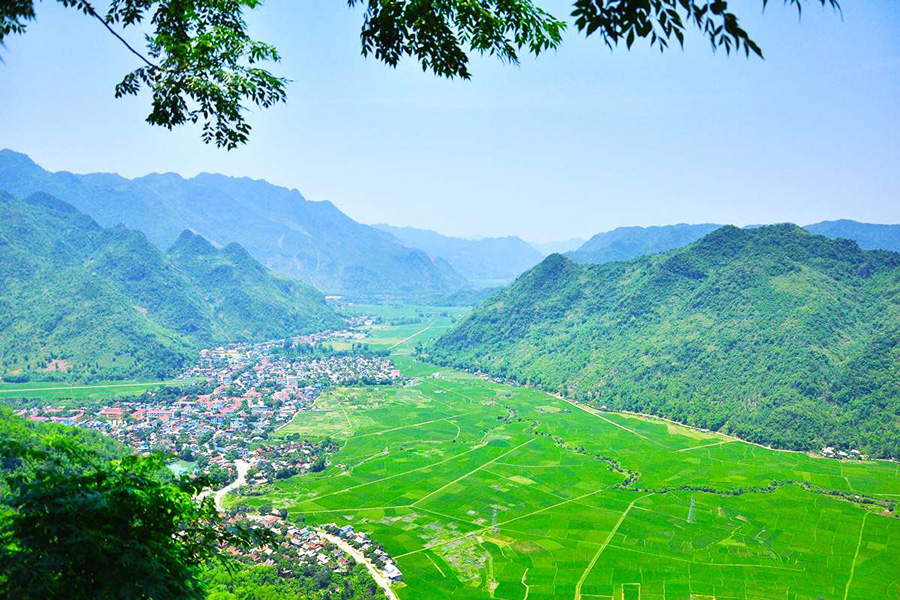
Traveling to Mai Chau, a rural valley of towering cliffs, unique culture and laid-back atmosphere, visitors will be delighted to experience the land and lifestyle of Vietnam’s northwest. Set in an idyllic valley, hemmed in by green hills, the Mai Chau area is a world away from Hanoi’s hustle, where Thai people reside and live in traditional stilt houses right on the edge of vibrant rice fields. If you wish to seek peace of mind with complete relaxation, Mai Chau is indeed a great place to go.
2. Enjoying the panorama view from Thung Khe Pass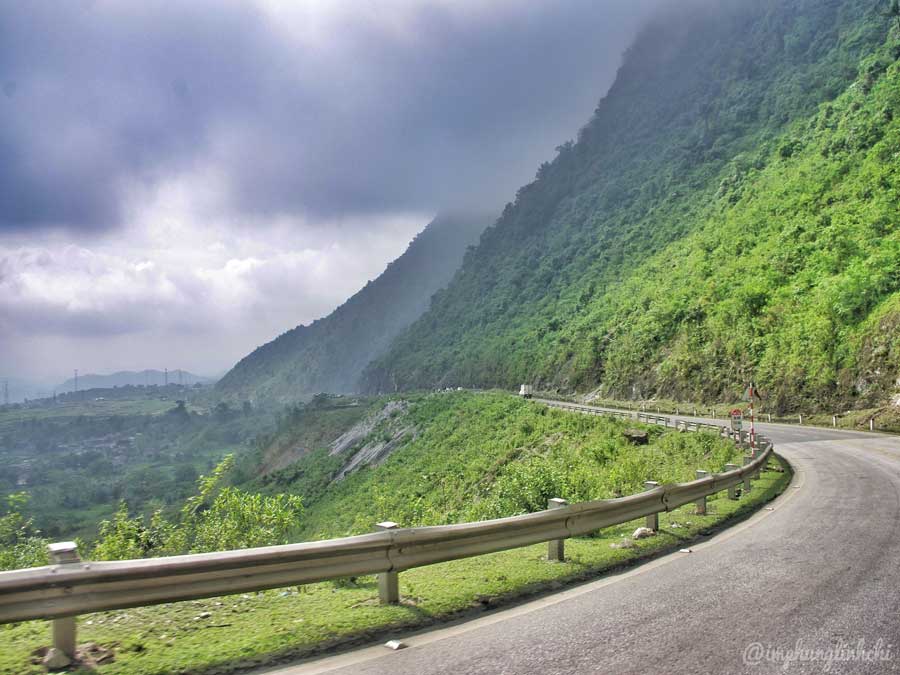
You will pass by and take a rest stop at Thung Khe Pass on the way to Hoa Binh from Hanoi, most likely. Standing on the peak of Thung Khe Pass at about 1,000 meters above sea level, you can feel the cool winds blowing over you while witnessing the picturesque valley underneath looked like a green carpet full of vitality. To warm up yourself, you can sit down at one of the leafy stalls to eat the local fare sold by the area’s Muong tribes people: a newly boiled or grilled corn and sugarcane, or the sticky-rice dish called Com Lam.
3. Swimming at the Mu Waterfall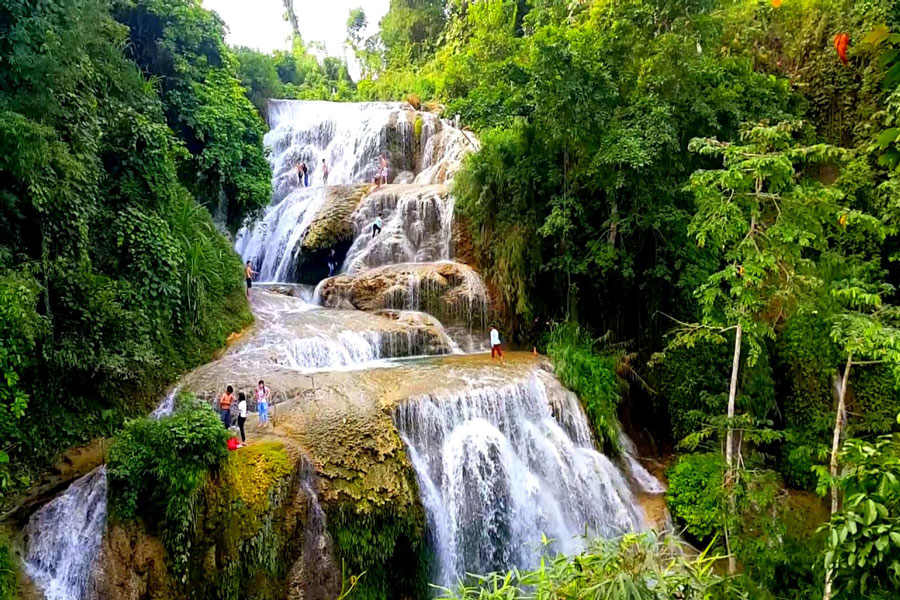
This waterfall is situated in Mu Village, at an altitude of over 1,000m, under the first floor of the majestic Truong Son range. Set among wild ruins and fig-scented woodlands, the waterfall is an ideal spot for dipping in the water. From a far distance, the visitors can hear the sound of water. Climbing down the short stone steps, around the groves, you are fascinated by Mu waterfall with white water foam.
One of the highlights is the foot waterfall segment with the height of 100m due to the water flow for many years, creating spectacular blue water like a large natural swimming pool.Stepping down to the waterfall is great as without any doubt that nature has endowed this place with the blue water, huge cool down the cliff into each floor. Along the waterfall from downstream to upstream, there are murky canopies and the tourists can glaze by this way to challenge each floor.
When coming to the Mu waterfall, the tourists can spend overnight here at a homestay, and enjoy the local specialties such as mountain snails, crabs, forest vegetables, fish, rice and so on.
4. Discovering the Pom Coong Village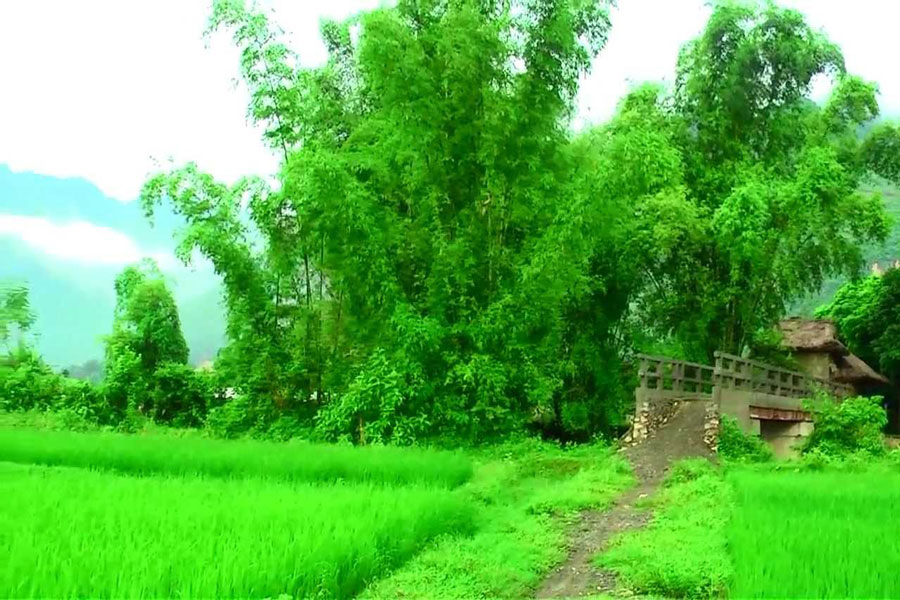
Pom Coong is a Thai village that is the least touristy than its neighbor with just equally beauties and attractions. There are only seven major families of 70 households with 300 people living together happily in Pom Coong. Like other villages in Hoa Binh, Thai people in Pom Coong Village often concentrate in hilly areas where there are both rivers and streams. Their houses are typically leaned back the mountains and overlook the ever-stretching rice fields in front. At the foot of the stilt-houses, Thai girls passionately ply with the looms to make up unique brocade products, making the interesting scene to see. Tourists are invited to Pom Coong Village to enjoy the idyll nature, wooden stilt houses, traditional performances, and of course, a wonderful homestay.
5. Visiting the Pu Luong Nature Reserve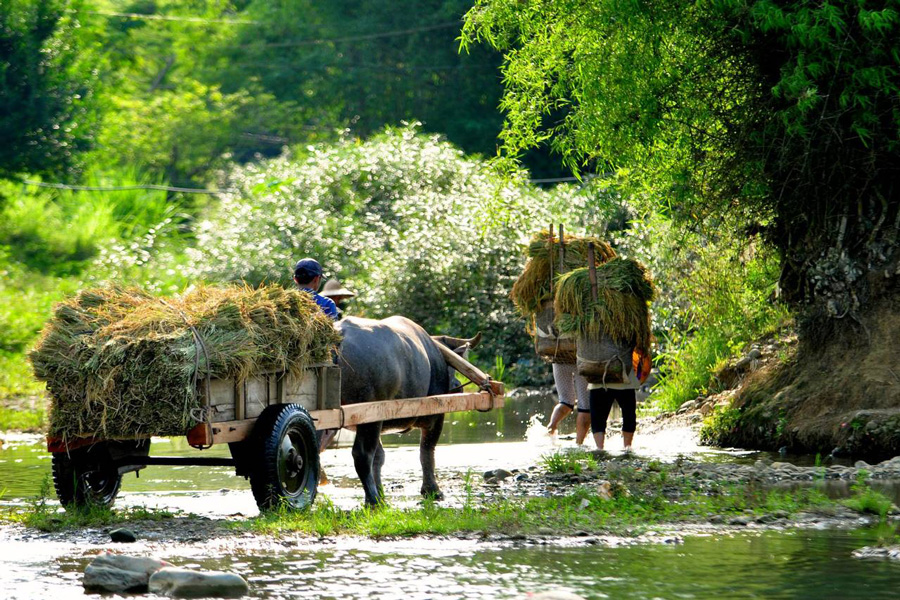
Pu Luong Nature Reserve is only 35 kilometers away from Mai Chau, making it a refreshing day trip from the valley. Pu Luong Nature Reserve attracts tasteful tourists thanks to its outstanding beauty of imposing mountains, intact waterfalls, immense terraced fields, as well as rich biodiversity along with Thai and Muong ethnic’s cultural values. An interesting combination of natural and man-made influence makes this breathtaking scenery become an ideal destination for nature lovers, who wish to escape the bustle of city life and enjoy the untouched charming land of minority groups of North Vietnam.
6. Exploring the majestic caves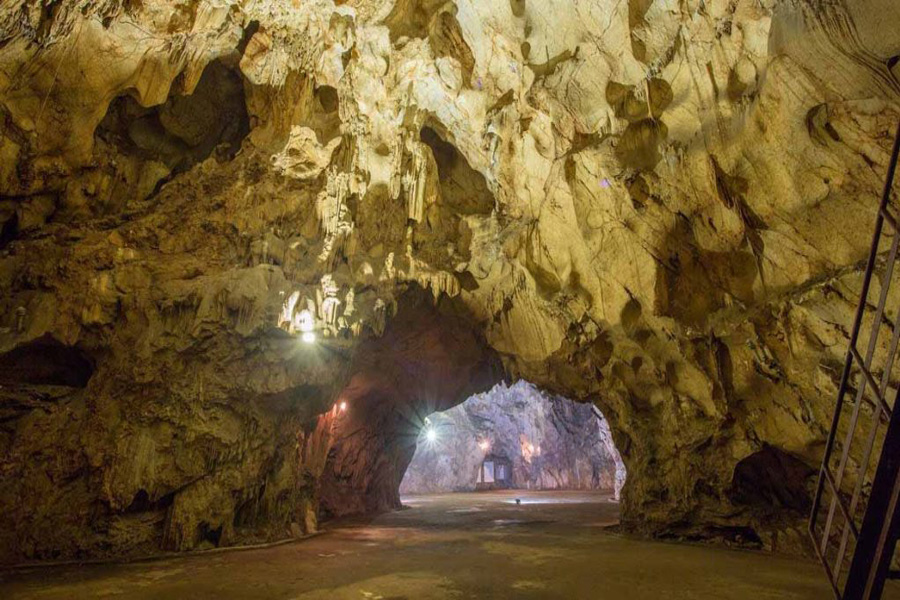
If you’re a fan of caves and the underground world, Mo Luong Cave and Chieu Cave are the places to go.
The famous Mo Luong Cave, which boasts marvelous blocks of stalactites and stretches about 1,800m into the interior of Mount Phu Ka, is accessible by two separate entrances that overlook the stretching rice paddy fields and the villages. Mo Luong cave expands into a large cathedral interior that then branches out to four different caverns. Besides, the impressive Chieu Cave extends its interior 600m into the mountain, branching out to two chambers and can only be reached by a 1,200-step staircase. Conquering these two caves has never felt your excitement.
7. Hiking at Thung Nai Valley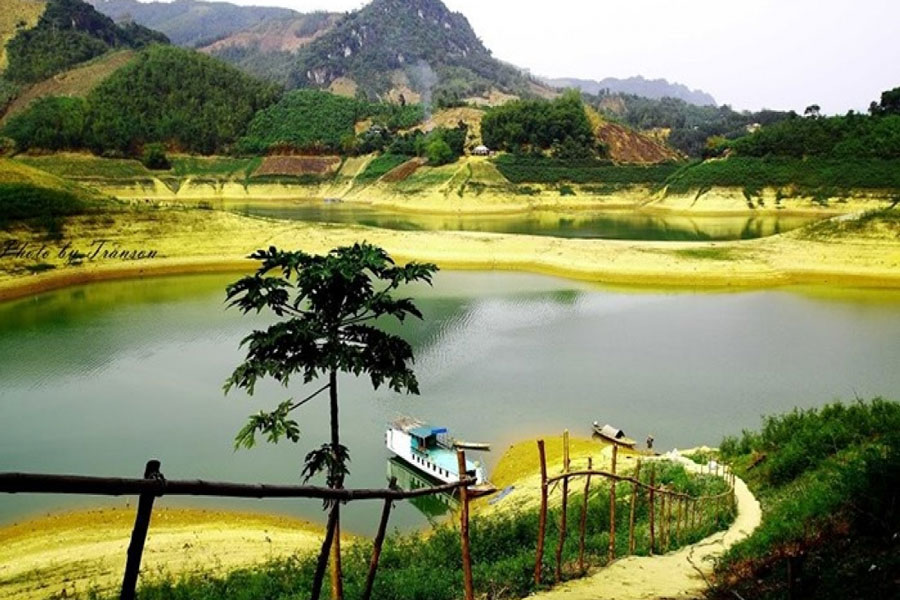
Thung Nai attracts the visitors from the very first sight with the harmonious combination of lakes, mountains, and charming houses nestled among the high hills. Thung Nai used to be a great valley covered by the vast forest, which was home to numerous deer. Therefore, the local people named it “Thung Nai” means “the Valley of deer”. Imagine you are traveling on the romantic green surface of Da River through winding currents and wonderful views along its sides, you will find peaceful relaxing time with family or friends, forgetting all about the stresses of busy life and enjoying stunning natural wonders.
8. Visiting the Hoa Binh Hydropower Plant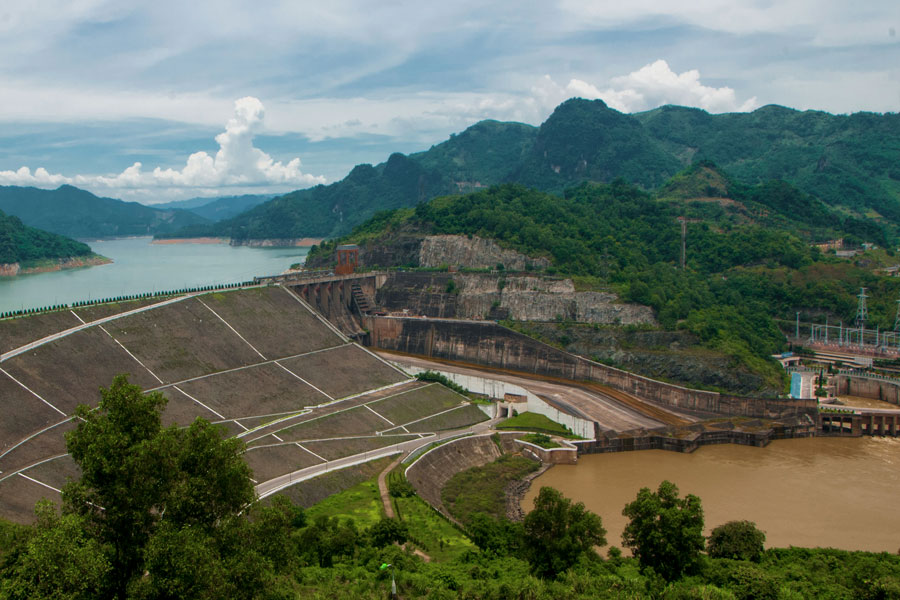
The Hoa Binh hydropower plant, the largest hydropower plant in Vietnam and Southeast Asia was built in 1994 at Hoa Binh lake, Hoa Binh province, on the Da River in northern Vietnam with the support of the Soviet Union for construction and operation instructions. Hoa Binh hydropower plant has a combination of rock dams, underground water to the turbine, the traffic tunnels system, operating system, and engineering systems, etc.
This hydropower plant is vital with multi-purpose, including Da River water management, natural disaster mitigation for the Northern Delta and Hanoi capital, and electricity production to provide for the socio-economic development of Vietnam and serving people’s daily life. That is the reason why Hoa Binh Hydropower Plant has been considered the “Century Project” of the country, and one of the most valuable architectural works of Vietnam.
9. Shopping hand-made souvenir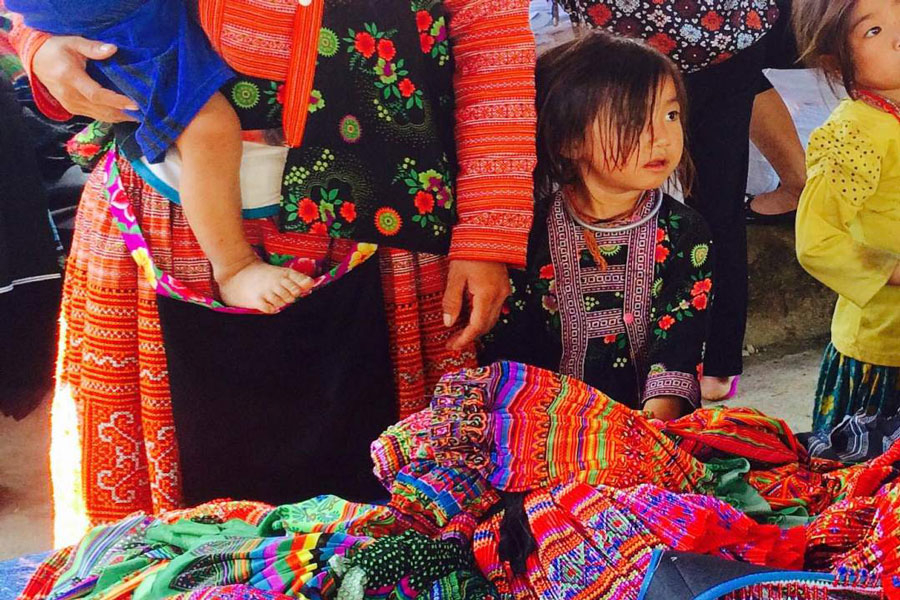
Hoa Binh, particularly Mai Chau, has no shortage of local handicrafts and intricate fabrics woven by skilled weavers on ancient looms. Thai brocade fabrics have been known for the rich colors, raised patterns and recent years, very stylish and fashionable. Silk brocade and hemp brocade are made and dyed meticulously and entirely from natural elements. And you can rest assured that the fabrics are not toxic to your skin at all.
10. Joining the Pa Co Market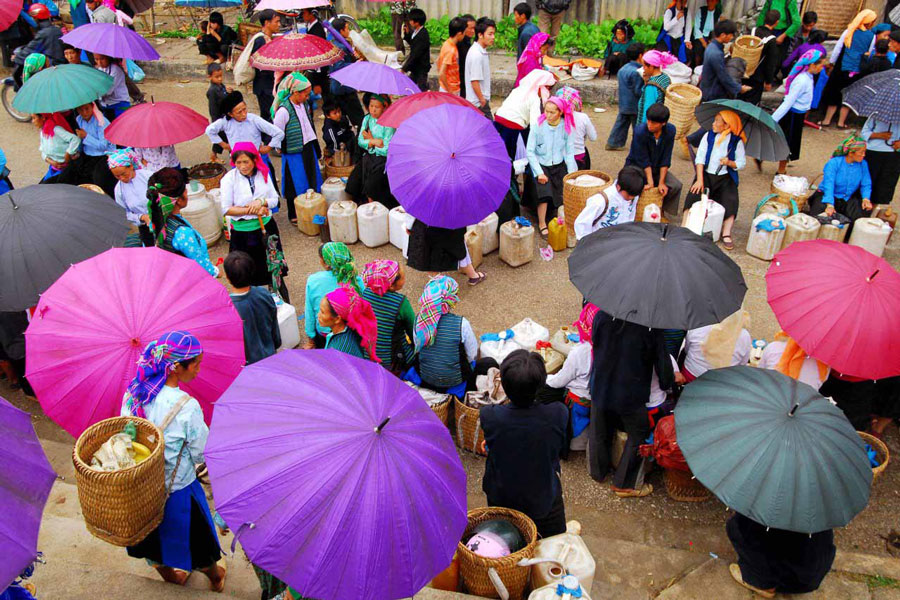
On every Sunday mornings, Pa Co fair market takes place like a small weekly festival to the ethnic people, where you can witness the true customs and habits of locals. Lying between Mai Chau and Moc Chau, Pa Co Market is the meeting point of two ethnic groups: H’ mong and Thai. The bustling atmosphere of the market is so special compared to the quiet feeling of the weekdays, as people will bring their self-made and self-grown products to trade to others. Joining Pa Co Market must be your unique experience while traveling Hoa Binh.
Wondering how long should it take to visit Hoa Binh? Let’s have an idea from our suggested 2-day & 1-night itinerary below of incredible things to do, for your best experience when traveling Hoa Binh.
Day 1: Mai Chau arrival – Mai Chau Valley – Pom Coong Village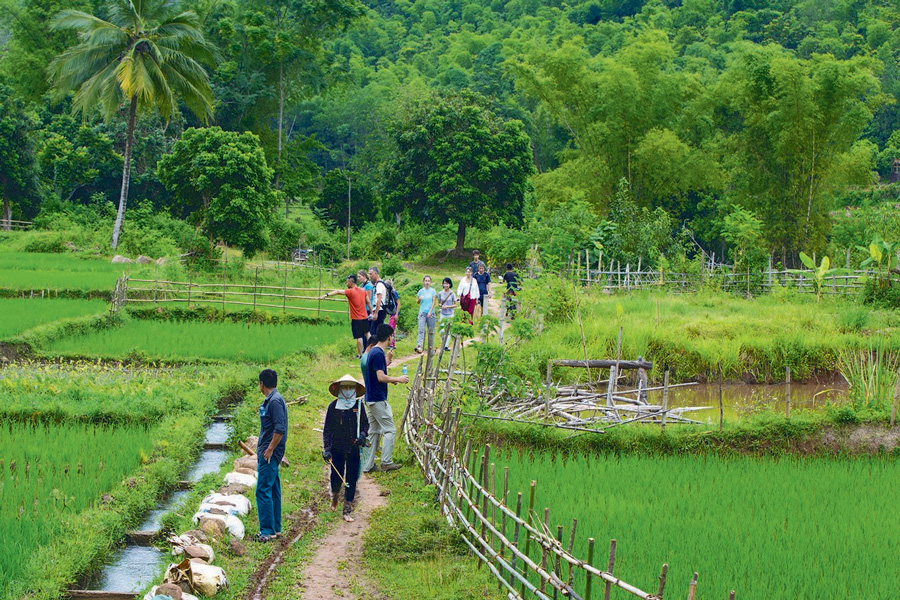
AM: Departing from Hanoi and reaching Mai Chau at noon. Have lunch with locals.
PM: Trek though Mai Chau Valley to Pom Coong Village. Enjoy sightseeing and learn the practices. Have a homestay at night after joining a dinner with traditional dancing, special foods and drinks made by Thai people.
Day 2: Pu Luong Nature Reserve – Hoa Binh Hydropower Plant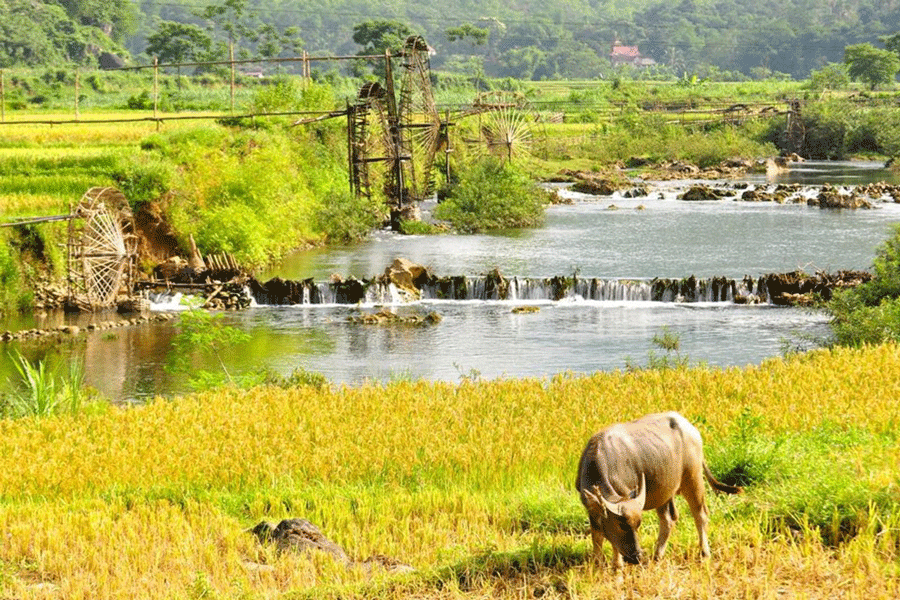
AM: Head to Pu Luong Nature Reserve. Spend a half-day hiking, swimming, kayaking or bicycling.
PM: Visit the Hoa Binh Hydropower Plant to witness the masterpiece of the industry in Vietnam. Then return to town. Experience light local foods. Shop souvenirs and prepare to return to Hanoi.
If you are a vetaren backpacker, please feel free to manage the trip on your own and alter it when needed, else, we recommend you join a tour organized by a professional company, that can free you from hassles and keep you safe throughout the journey.
Visiting the land without tasting its specialties will make your trip an incomplete experience. Wondering what to eat in Hoa Binh? Let’s find out below.
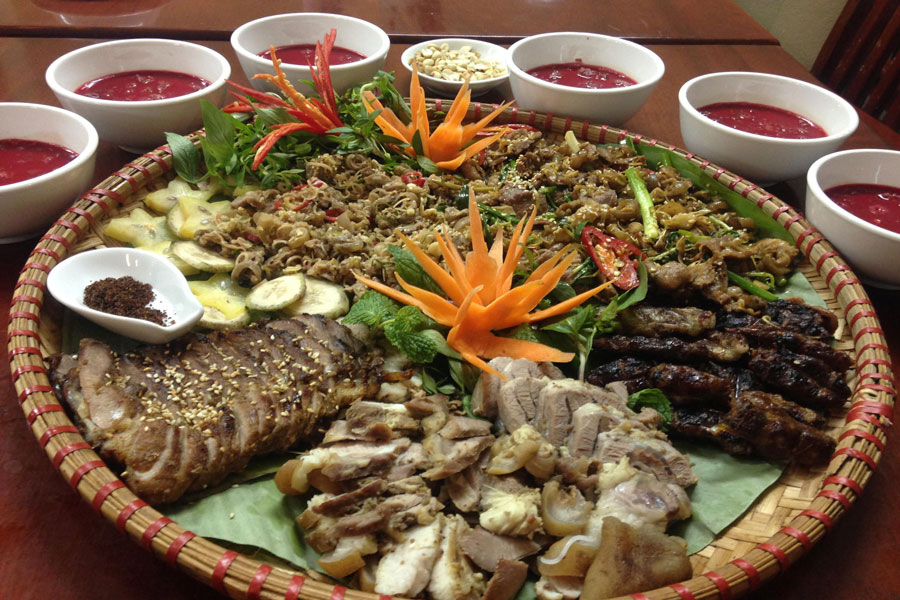
1. Lon Man: The highland pigs are naturally raised by the locals in Mai Chau. The pork meat is known for lesser amount of fat and tastiness.
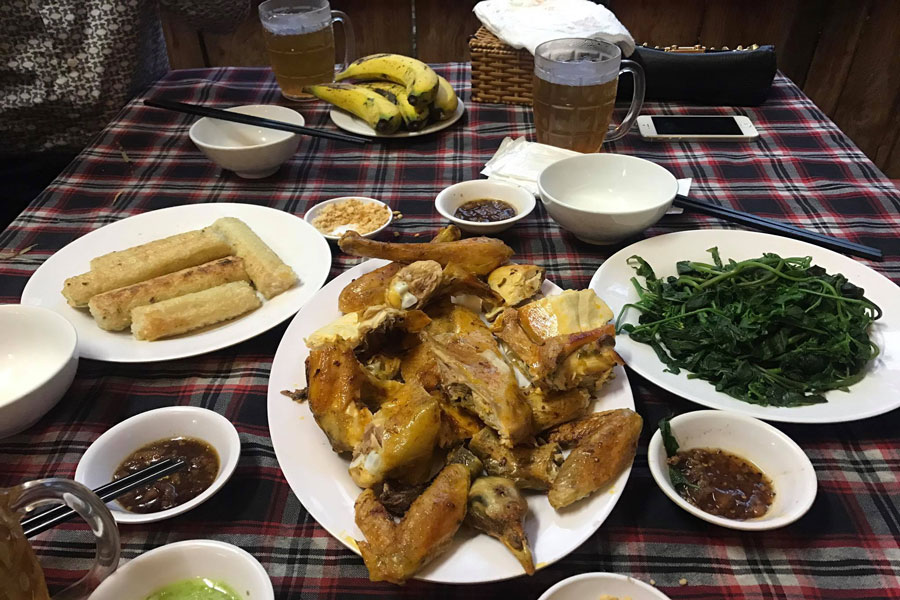
2. Ga doi: This barbecue gritty chicken dish is a favorite for many food-lovers when getting around here. The chickens are barely raised by farmers, and they have to run up to the hill to find food by themselves. Therefore, the chicken’s legs are especially delicious. They are not as big as the normal chickens but the meat is firm and fragrant.
The chicken is baked in charcoal without smoke or steamed with lemon leaves. Tearing each piece of chicken along with the Cham Cheo will give excellent taste.
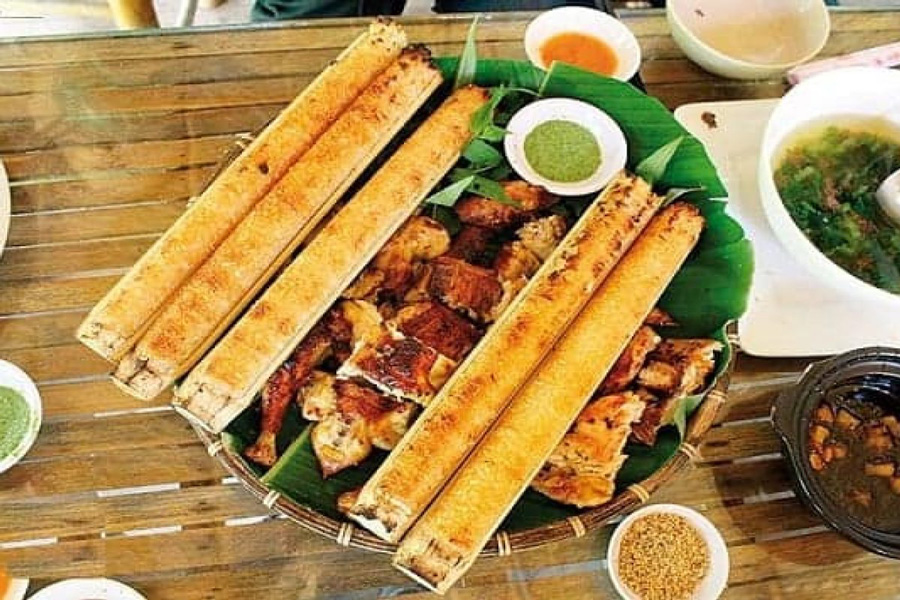
3. Com Lam: is the most famous Thai dish which you can easily find in Mai Chau. Boiled rice in a small long roll of bamboo makes the food taste well. It is soft, sticky, and aromatic.
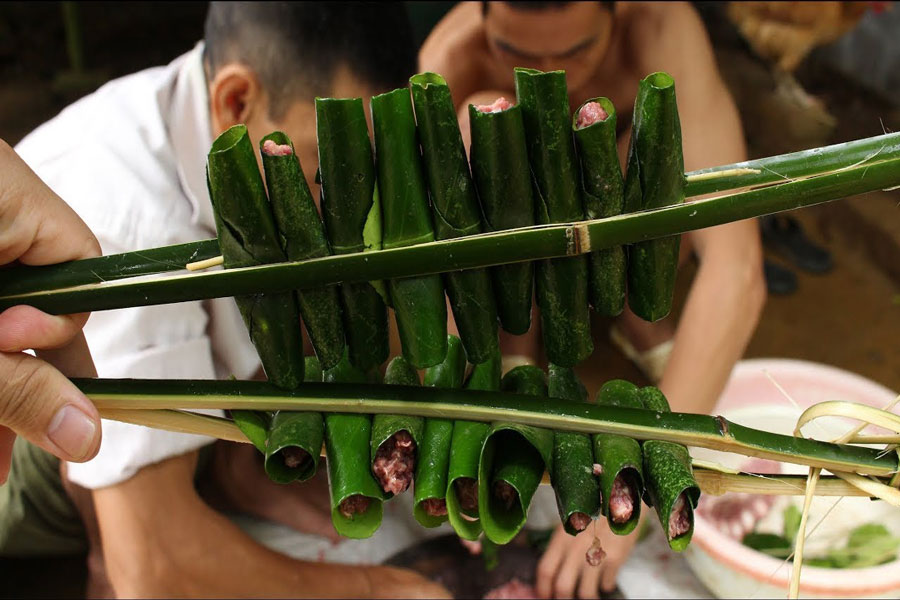
4. Grapefruit leaves pork roll: You can find this dish in Lac Village around March. This dish is a specialty of Muong people. Bacon is cut into pieces that are equal to knuckles. Every piece is wrapped by half of a grapefruit leaf, which is then grilled on coal. During the cooking, the flavor of the pork is added by the leaves’ aroma.
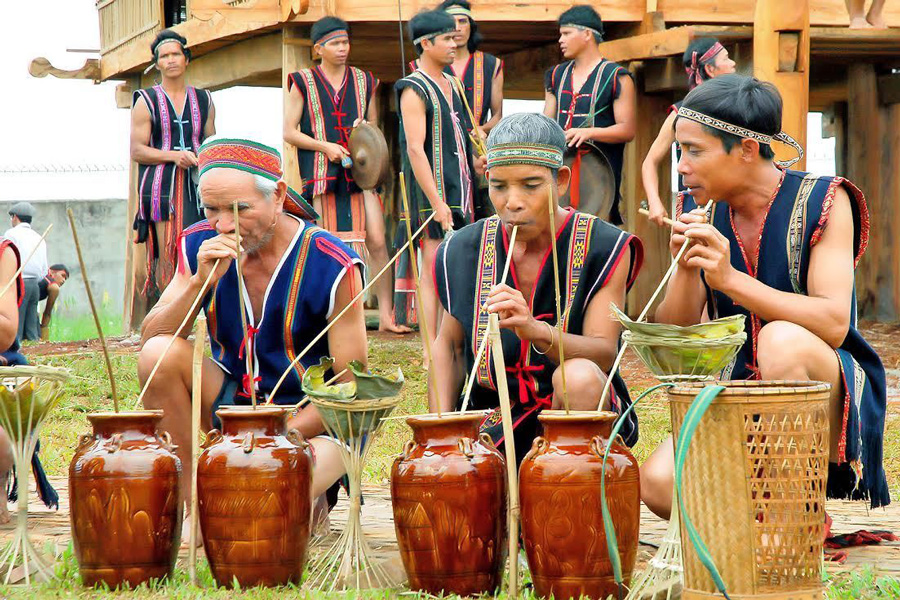
5. Can Wine: The alcohol is prepared meticulously with ginger, herbal medicine, fruits and many kinds of forest leaves with oil. The wine is made from grains such as cassava, glutinous rice, berry seeds and nuts. The ingredients are fermented into the pot or jar. The more mature the wine is, the more delicious it is. People do not drink alcohol from cups or bowls, rather using one-meter-long bamboo sticks that are flicked, straightened and pierced through the intestine then bent into the wine bottle.
The climate in Hoa Binh, which is tropical monsoon, creates some interesting temperature extremes: dry, cold winters from January to February with a temperature range of 15-17 degrees Celsius, and wet, hot summers from June to September with a temperature range of 26-28 degrees Celsius.

The best time to visit Hoa Binh should fall between these highs and lows. The spring months from the latter half of February to the end of May brings pleasantly warm weather, with the flowers all a-blossom during this time. The autumn months from October to November bring a tolerable chill but still allow for pleasant hiking throughout the valley.
From Hanoi, there are several options for transportation for you to take to get to Hoa Binh.
1. Public bus: The most direct route to Hoa Binh begins at My Dinh Bus Station in Hanoi, where the buses depart four times a day – with ticket fare starting at $17.
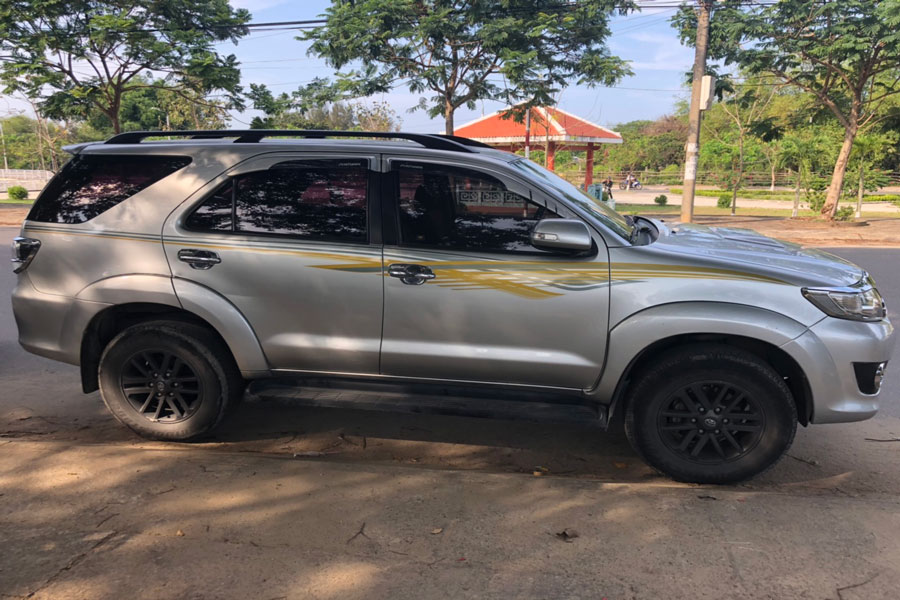
2. Private car: This is the option of convenience. The trip takes about 3,5 hours with the cost of $100 for one way traveling.
3. Motorbike: In addition, you can rent a motorbike to drive yourself to Hoa Binh. Although renting a motorbike is not a big deal, we do not encourage you to do this, especially when you first come to Vietnam. Ensure your safety first.
Throughout this article, we wish you to have an idea of how to travel to Hoa Binh for your best experience. In case you are looking for your own travel agent, who can offer a wonderful and hassle-free trip to Hoa Binh, please feel free to let us know. We always commit our best to make it your once-in-a-lifetime journey.
 France
France  Spain
Spain  German
German  Italian
Italian 

 Vietnam Tours
Vietnam Tours  Cambodia Tours
Cambodia Tours  Myanmar tours
Myanmar tours  Thailand Tours
Thailand Tours  Laos Tours
Laos Tours